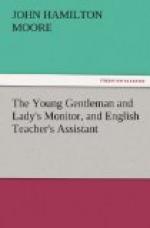The difficulty of describing action by words, will be allowed by every one; and if we were never to give any instructions but such as should completely answer our wishes, this difficulty would be a good reason for not attempting to give any description of it. But there are many degrees between conveying a precise idea of a thing, and no idea at all. Besides, in this part of delivery, instruction may be conveyed by the eye; and this organ is a much more rapid vehicle of knowledge than the ear. This vehicle is addressed on the present, occasion, and plates, representing the attitudes which are described, are annexed to the several descriptions, which it is not doubted will greatly facilitate the reader’s conception.
The first plate represents the attitude in which a boy should always place himself when he begins to speak. He should rest the whole weight of his body on the right leg; the other, just touching the ground, at the distance at which it would naturally fall, if lifted up to shew that the body does not bear upon it. The knees should be strait and braced, and the body, though perfectly strait, not perpendicular, but inclining as far to the right as a firm position on the right leg will permit. The right arm must then be held out with the palm open, the fingers straight and close, the thumb almost as distant from them as it will go, and the flat of the hand neither horizontal nor vertical, but exactly between both. The position of the arm perhaps will be best described by supposing an oblong hollow square, formed by the measure of four arms, as in plate the first, where the arm in its true position forms the diagonal of such an imaginary figure. So that, if lines were drawn at right angles from the shoulder, extending downwards, forwards, and sideways, the arm will form a& angle of forty-five degrees every way.
When the pupil has pronounced one sentence in the position thus described, the hand, as if lifeless, must drop down to the side, the very moment the last accepted word is pronounced; and the body, without altering the place of the feet, poise itself on the left leg, while the left hand rises itself into exactly the same position as the right was before, and continues in this position till tine end of the next sentence, when it drops down on the side, as if dead; and the body poizing itself on the right leg as before, continues with the right arm extended, till the end of the succeeding sentence, and so on from right to left, and from left to right alternately, till the speech is ended.
[Illustration: PLATE I.]
[Illustration: PLATE II.]




